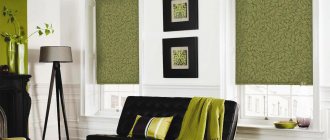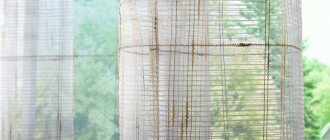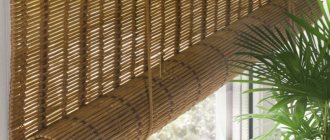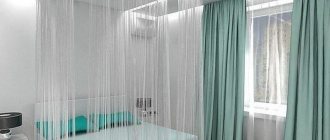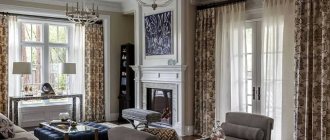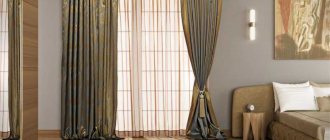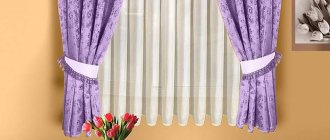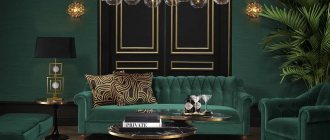In houses and apartments, not only heavy curtains are hung on the windows, but also light, airy tulles. They are made from organza, veil, and mesh. Products can be matte, sparkling, patterned, or plain. Choosing the right tulle for your interior is easy. Properly selected curtains will give the room a beautiful look, comfort, and warmth. To understand which tulle is better, veil or organza or mesh, you should study the features and properties of each and understand.
Tulle is several types of light translucent fabrics used to decorate window or door openings.
Combination colors
- white-black;
- beige with brown.
- beige-silver;
- white-red;
- blue-pink;
- orange-green;
- red-yellow.
How to care?
Caring for curtains is very simple. Voile curtains can be washed in a washing machine at a temperature not exceeding 30 degrees using gentle detergents.
The veil should not be wrung out, as it wrinkles easily. However, it’s worth mentioning right away that, thanks to the fine-mesh structure of the fabric, even unwrung curtains dry quickly enough.
After washing, you must immediately hang the curtains. You can hang them directly on the curtain rod until they dry completely, so there are no creases in the fabric.
Ironing of veils is carried out using the following technology:
- You can only iron a completely dry veil.
- Iron temperature is approximately 110 degrees.
- Place a damp cotton cloth over the veil.
- Gradually press the fabric with an iron, smoothing out the folds. You should not iron the curtains directly, this will not give the desired effect.
- As it dries, spray the cotton fabric with water from a spray bottle.
- Repeat the procedure, gradually treating the entire curtain.
- Hang the slightly warm material on the curtain rod and let it cool completely.
Voile curtains should not be vacuumed or a steamer used. You risk damaging the structure of the fabric and in the future it will lose its attractive appearance and may even tear.
Advantages of voile curtains
- Do not darken the room during the day.
- Protect your home from prying eyes from outside the window.
- The soft texture makes it possible to drape the fabric into graceful and sliding folds;
- Models embroidered with silk or decorated with images look interesting.
- Affordable price.
- Not demanding in care.
- The veil is great for creating voluminous lambrequins.
- This fabric is valued for its softness and pliability.
- Possibility to combine many color variations.
- Breathability.
Recommendations for decorating rooms
The rooms in the house have a specific purpose and location; people of different ages and genders live in them. You can choose the right tulle veil for your apartment windows only by taking these factors into account.
Related article: Laminate for water-heated floors: which one is better to choose, heating and installation, thermal conductivity and labeling
Kitchen
Considering the specifics of the room, it is better to purchase a curtain made of polyester. The model should have a simple cut, because rich drapery will make it difficult to wash the curtains. The main thing for a kitchen curtain is functionality. First of all, you should consider a version shortened to the window sill, as well as arched curtains. A curtain on a kitchen window can only be a decoration, and protection from the sun, light and prying eyes will be provided by unpretentious horizontal or roller blinds.
The color of the curtain is chosen to match the interior, but it is better to choose light shades - the kitchen will look more spacious.
Living room
This is a place for bold decisions and the realization of fantasies. In the living room, depending on the style in which it is decorated, you can hang any curtain made of tulle voile.
Living room model
The classic interior is complemented by light curtains of any color with lush drapery. Lambrequin and tiebacks are used. You can give the tulle a beautiful shape using clips. Embroidered, striped or lace fabrics are perfect for a classic living room.
For a rustic style, choose a curtain made of polyester or based on cotton fibers. Such an interior can do without curtains if the tulle is lavishly collected. Provence style will prefer a soft lilac curtain.
High-tech is complemented by a light gray color on the windows or fabrics with a metallic sheen. A beautifully decorated veil with gold plating will emphasize the pomp of the Baroque. A cheerful urban style will be completed when using green, yellow, orange, and blue shades of tulle. A curtain with a geometric pattern is chosen for a living room in the Art Nouveau style.
Children's
Voile curtains will add tenderness and softness to the room, because the fabric does not create frozen shapes like organza. If there is a prejudice against artificial fabrics, then using a cotton voile will solve the problem of environmental friendliness. The choice of color depends on the gender and age of the child:
- Girl's room - delicate shades of yellow, orange, lilac, pink are suitable
- Boy's room - discreet blue, blue, gray, purple tones are used
- Neutral interior - create white, pale green, beige shades
Tip: Don't experiment with bright colors on the window in your child's room. Subdued tones and muted colors have a positive effect on the psyche of children.
Bedroom
Curtains made of voile will create a special atmosphere, because the fabric drapes easily and holds folds perfectly. If curtains are not used, then tulle with a thick pattern is purchased for effective sun protection. The window is decorated with a lambrequin, and tiebacks or pins will help to arrange the curtain beautifully.
Related article: DIY postcards for March 8th: ideas and 6 master classes
Pastel colors, embroidered or lace curtains will be preferable.
Flaws
- quickly become contaminated.
- Over time it loses its color.
- poorly ironed;
- When washed at high temperatures, the veil may lose its aesthetics.
Important: the veil does not need to be wrung out. When washing by hand, such curtains should not be twisted.
When purchasing voile fabric for curtains, you need to consider the following nuances. If you hang white curtains made of natural fibers in the kitchen, the settling splashes of grease will collect dust. It will be difficult to remove the absorbed dirt and this work will have to be done frequently.
It is better to take a synthetic veil of darker colors. There are numerous of them. You can choose different colors of voile curtains. The main thing is to take all factors into account.
Types and composition
Initially, a veil was a small piece of fabric that covers a woman’s face when she goes out into the world.
Classic voile is a light, translucent, matte cotton fabric of plain weave. The texture resembles thick gauze. Over time, its fiber composition has undergone changes: linen, silk, and wool varieties have appeared. Even later, with the invention of synthetic fibers, veil fabrics began to be produced from polyester threads.
Plain weaving is obtained when, upon reaching the surface of the fabric, one warp thread alternates with a weft thread along the entire width and length. Plain weave fabric has the same front and back sides.
Initially, the veil is a cotton fabric resembling gauze.
Microveil has a denser and more transparent texture.
Modern veil - produced bleached, plain-dyed, printed. It is characterized by delicate pastel colors, but is not alien to bright colors. The ombre coloring on veil fabric looks interesting - the color gradually changes from rich dark, through many shades, to cloudy white. Today, more and more often there are products with a pattern all over the canvas, a border, a coupon - with a large pattern along the edge, smoothly decreasing towards the center.
The drawings further emphasize the sophistication of the veil. They are created in different ways: by printing, embroidery, devore etching, when the image is developed under the influence of reagents. For etching, a mixture of polyester with viscose or linen is used.
Polyester is used as the main raw material for the manufacture of modern veils. Completely natural fabric made of wool and silk is extremely rare today and is expensive, since such fabrics belong to the elite class.
Voile colors for curtains
White is a classic color suitable for any setting.
Black is a universal color that has not gone out of fashion for years and fits into any style.
Gray is reserved and noble.
Beige - gives the room an atmosphere of peace and tranquility.
Green is a great option to refresh the interior space of any room.
Orange – curtains of this color can be a wonderful “refreshing” element.
Lilac - will be bright and look original in various interiors.
Blue - cool curtains of this color make the room elegant, respectable, and rich in its own way.
Red – focus attention on the image of the window.
Pink is associated with tenderness, tranquility and comfort.
Yellow is the color of joy and happiness.
Properties and applications
A veil on a window opening is a type of curtain. It is often confused with organza. But it’s easy to distinguish them: the veil is softer, more pliable than organza, has a matte surface, less transparent, and drapes more easily. Draperies look exquisitely airy, and when the wind blows or in motion, they form beautiful flowing waves. Thanks to these advantages, as well as good hygroscopicity and breathability, it is ideal for sewing:
- light curtains, exquisite lambrequins;
- ceiling canopies, canopies for adult beds and cribs;
- elegant dresses and blouses;
- romantic wedding dresses;
- decorative jewelry (flowers, inserts, veils for brides).
The disadvantage of this material is considered to be high creasing. Moreover, creases that are difficult to remove can form on synthetics. In addition, it fades in the sun.
Luxurious wedding dresses are made from this fabric.
Delicate veil canopy in the interior of a baroque style bedroom.
Photos of voile curtains
Decoration elements
Let's look at the most common elements of curtain decoration.
- Pickups. This element will be revived and will add a soft elliptical line to a straight curtain. The design of tiebacks is varied - metal, fabric, tassels, floral arrangements, etc. The visual effect of the entire space as a whole depends on the height of the hook with tiebacks. So, you can visually expand the space in width, or increase the room in height.
- Lambrequins. The finished image of curtains is set by lambrequins, but their participation usually comes down to decorating the window in a classic style.
- With beads. The presence of beads in the curtains transforms the image of the window, setting a note of playfulness and romance. A wonderful addition to the beads will be small inclusions of small tassels and rhinestones.
Material
Tulle veil can be made from natural fibers or be completely synthetic. Basic materials for its manufacture:
- Silk is a natural material made from the thread of the silkworm pupa. It is characterized by unsurpassed softness and smoothness. But the price of this material is quite high.
- Cotton . This type of fabric is a little cheaper than the previous one, but also looks great.
- Synthetics . Artificial veil is also good, although much cheaper than its natural counterparts. It is easier to care for. The tulle veil does not shrink during washing, wrinkles less during use, and practically does not fade. Also, artificial fabric is easier to iron. The light transmission properties of this material are slightly higher than those of silk and cotton.
In addition, there are mixed fabrics that combine natural and artificial threads.
There are a huge number of types of tulle that are made from veils:
- A simple rectangular fabric hanging down in loose folds. There can be one or several of them on the window, made in one color or have several shades. They can be used in one layer, two or more, creating volume on the window.
- Crossed from two canvases. In this case, the curtains also have a rectangular shape. They can be either short or long. Tulle veil sheets are assembled using various accessories on the opposite side of the window.
- Italian curtains. Here the curtain fabric is gathered up to the cornice and simply thrown over it or passed through a decorative ring.
- French curtain. The veil is gathered into symmetrical flounces. In this case, it is possible to change the height of the curtain. In this case, the shuttlecocks should be preserved even with the maximum lowering of the canvas.
- A lambrequin made of tulle-veil also has its place. To do this, the main curtain fabric can be fancifully thrown over the curtain rod.
Material
Tulle veil can be made from natural fibers or be completely synthetic. Basic materials for its manufacture:
- Silk is a natural material made from the thread of the silkworm pupa. It is characterized by unsurpassed softness and smoothness. But the price of this material is quite high.
- Cotton . This type of fabric is a little cheaper than the previous one, but also looks great.
- Synthetics . Artificial veil is also good, although much cheaper than its natural counterparts. It is easier to care for. The tulle veil does not shrink during washing, wrinkles less during use, and practically does not fade. Also, artificial fabric is easier to iron. The light transmission properties of this material are slightly higher than those of silk and cotton.
In addition, there are mixed fabrics that combine natural and artificial threads.
There are a huge number of types of tulle that are made from veils:
- A simple rectangular fabric hanging down in loose folds. There can be one or several of them on the window, made in one color or have several shades. They can be used in one layer, two or more, creating volume on the window.
- Crossed from two canvases. In this case, the curtains also have a rectangular shape. They can be either short or long. Tulle veil sheets are assembled using various accessories on the opposite side of the window.
- Italian curtains. Here the curtain fabric is gathered up to the cornice and simply thrown over it or passed through a decorative ring.
- French curtain. The veil is gathered into symmetrical flounces. In this case, it is possible to change the height of the curtain. In this case, the shuttlecocks should be preserved even with the maximum lowering of the canvas.
- A lambrequin made of tulle-veil also has its place. To do this, the main curtain fabric can be fancifully thrown over the curtain rod.

